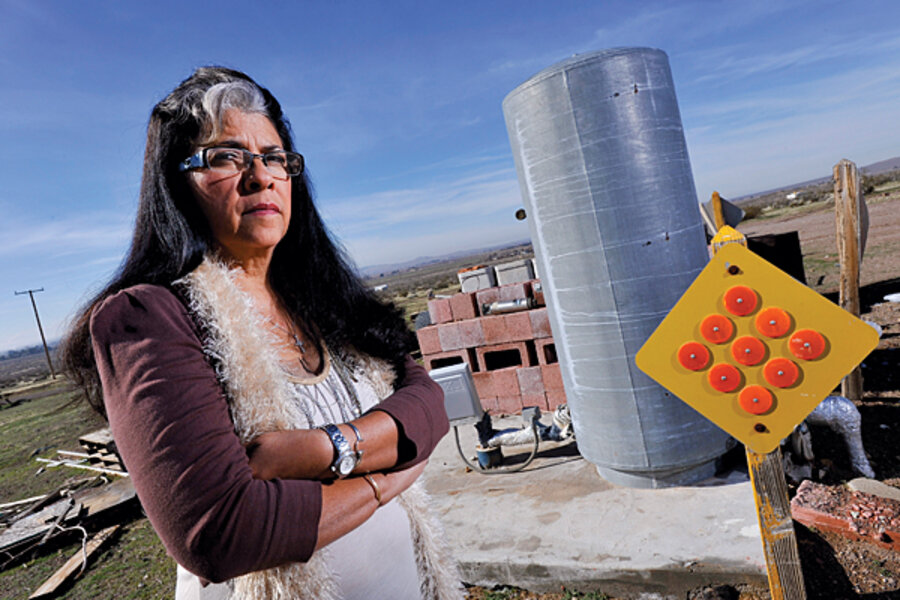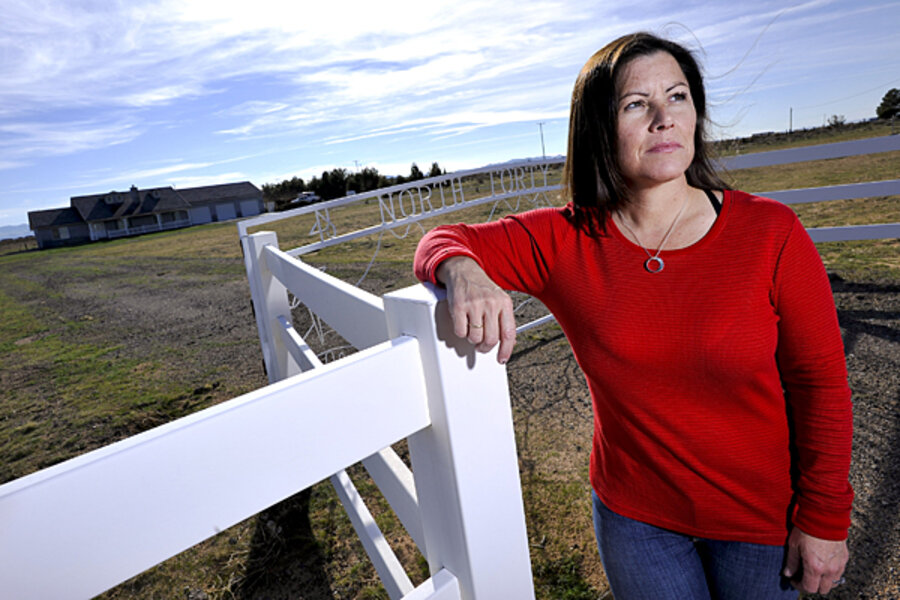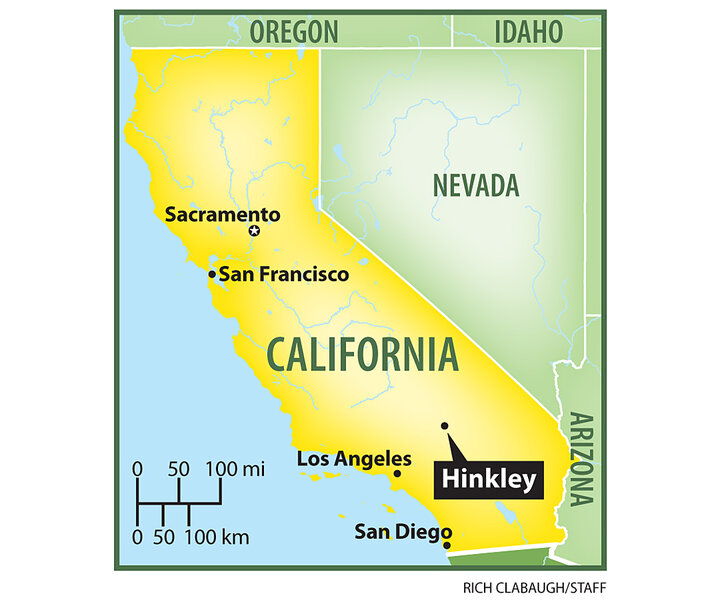For town made famous by 'Erin Brockovich,' a toxic sequel?
Loading...
| Hinkley, Calif.
This past Christmas may have been Karen Dodd's last chance to be Santa Claus.
Each year, Ms. Dodd reads the letters to Santa from the children on her mail route and grants their wishes, dropping off their gifts with a North Pole return address.
A Hinkley, Calif., native, she's saved the notes, planning to return them to the children when they grow up. But the future of this Mojave Desert community is uncertain.
Hinkley – made famous by the movie "Erin Brockovich" for the triumph of ordinary people over industrial polluters – faces a toxic sequel. The plume of hexavalent chromium that was at the heart of the movie has slipped past a containment barrier, complicating efforts to make the community's water safe.
Pacific Gas and Electric caused the contamination in the 1950s and '60s, when it used chromium 6, as it's also called, to fight rust in cooling towers, and then stored chromium-tainted water in unlined ponds. The substance leaked into Hinkley's ground water. By the early '90s, PG&E started buying up and demolishing homes in Hinkley.
Remediation efforts have brought down the contaminant level substantially, but some tests still show levels above the safety limit that state officials have set for Hinkley. After PG&E's well tests last year indicated that the plume was shifting, the company announced in December that it had offered to buy 130 more properties at the edge of the plume – most of them along Dodd's route.
"I feel horrible about it," she says. "This has always been home, and it's disappearing."
How dangerous is chromium 6?
Scientific and legal debate has raged over the risk posed by hexavalent chromium in drinking water since the 1990s, when Erin Brockovich, then an obscure legal file clerk, unearthed evidence that the substance had leached into Hinkley's ground water. Residents sued, and in 1996, PG&E paid a $333 million settlement to about 600 people who blamed exposure to chromium 6 for high rates of cancer and other diseases.
While many researchers say that hexavalent chromium is an inhalation carcinogen, some have claimed that the risks are negligible when the substance is ingested. But in 2009, National Toxicology Program (NTP) scientists reported that their research "clearly demonstrates" that the compound is a carcinogen in drinking water.
The American Chemistry Council counters that the rats in the NTP study were subjected to unreasonably high chromium exposures. It's sponsoring additional research.
Meanwhile, a California Cancer Registry survey for the census tract that includes Hinkley failed to find a disproportionately high disease rate. But George Alexeeff, deputy director for scientific affairs at California’s Office of Environmental Health Hazard Assessment (OEHHA), says Hinkley’s population is too small for a cancer survey to yield meaningful results.
In August 2009, OEHHA proposed a “public-health goal,” or ideal standard, of 0.06 parts per billion for chromium 6 in water. On Dec. 31, it revised the draft public-health goal to 0.02 p.p.b., in response to research that raised concerns about risks for young children and other sensitive populations.
The California Department of Public Health will consider that goal, as well as cost and feasibility of remediation, in determining whether to set a drinking-water standard for chromium 6.
What Hinkley is doing about it
In Hinkley, state water officials already have set a cutoff for human consumption of 3.1 p.p.b., and PG&E has been trucking in water for residents whose wells exceed that level.
State officials have issued a series of formal orders requiring PG&E to clean up the pollution. They're studying new remediation options and will decide on additional steps in May.
According to Lauri Kemper, assistant executive officer at the Lahontan Regional Water Quality Control Board, PG&E has sought to break up Hinkley's pollution by pumping millions of gallons of tainted water from deep underground, then using it to irrigate alfalfa fields.
As the chromium 6 filters through the soil, it interacts with microorganisms that convert it to healthful chromium 3. The company also is pumping in ethanol to stimulate the bacteria and injecting water back into the ground around the plume as a buffer, Ms. Kemper says.
Still, the plume is more than half a mile past PG&E's containment perimeter. And it's spreading at least a foot a day as heavy ground-water pumping by nearby farms sucks the contamination into previously untainted areas. PG&E's own pumping – part of the current remediation effort – may have accelerated the northern flow of the plume as well, Kemper says. Further, water-board records show that hexavalent chromium has penetrated a subterranean layer of clay that PG&E's remediation experts thought would protect a deeper aquifer.
With traces of naturally occurring chromium 6 in Hinkley's soil, says company spokesman Jeff Smith, it's difficult to determine whether a spike in test readings means the plume is growing. The boundaries of such plumes often shift with ground-water flows, expanding in one area while drawing back in another, Mr. Smith says.
"PG&E has worked very hard on a cleanup in the Hinkley area," he says. "We did use chromium in the 1950s and '60s in the way that's been described, and we've discontinued that. We're committed to a cleanup. But with some of what's going on, it will take study to determine the causes."
Smith stressed that the breach in the clay barrier between the upper and lower aquifers is at the center of the plume, which he says is far from any domestic or agricultural wells.
But a Lahontan water-board map shows the testing location that detected the breach is less than half a mile from the two closest domestic wells. A follow-up report is due at the end of this month.
Patience running thin
Bob Bowcock, an environmental investigator working with Ms. Brockovich, says he's seen similar remediation failures elsewhere.
"I am so sick of 'The solution to pollution is dilution,' " he says. "With a chemical that dangerous, they need to remove it from the environment. It should have been removed from the water supply and the concentrated chemical landfilled at a hazardous-waste landfill or incinerated."
Likewise, Mr. Bowcock says he's heard scores of claims that clay layers will prevent pollution from spreading. They never do, he says.
Bowcock says he and Brockovich will meet this month with residents who are considering new litigation.
PG&E is "absolutely committed" to a cleanup, Smith says. But the company's most recent feasibility study predicts it could take at least 110 years.
To activist Carmela Gonzalez, assurances like Smith's ring hollow. Her well shows one of the community's highest contaminant readings, and on Christmas Eve, Ms. Gonzalez had nearly finished packing her possessions to leave Hinkley forever. As she leafed through an album of photos she took while building her home, tears filled her eyes.
"I used to ride my horse here as a little girl, and I used to say, 'I want to live here one day,' " she said. "I'd thought it all through. I spoke to someone from PG&E. I spoke to somebody from the water board. I even called the county. They all said, 'Oh, you're miles from the compression plant. You don't have to worry about it.' "
Some chromium 6 exposure may occur nationwide, suggests a survey released last month by the Environmental Working Group, which is based in Washington. Of 35 cities tested in the survey, 31 had traces of hexavalent chromium. The highest recorded level was in Norman, Okla., with a concentration of 12.9 p.p.b. – a near match with the highest level seen recently in Hinkley. The average for the 35 cities was 0.18 p.p.b., nine times the proposed public-health goal in California.
In response to the findings, Democratic Sens. Barbara Boxer and Dianne Feinstein, both of California, called on the US Environmental Protection Agency to set a national chromium 6 standard. In written statements, agency officials say they already have a chromium 6 study under way and based on what they know so far, they say it's likely they will tighten the drinking-water standard for hexavalent chromium later this year.







